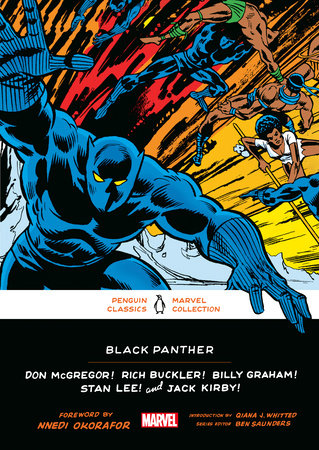READERS GUIDE
PENGUIN CLASSICS MARVEL COLLECTION DISCUSSION QUESTIONS
BY QIANA J. WHITTED FOR
BLACK PANTHER
1. Readers travel to Wakanda for the first time with the Fantastic Four in 1966. How does the Black Panther’s explosive interactions with each member of the Fantastic Four in these early issues reveal his motivations and strengths as a super hero?
2. Much of the astonishment and disbelief that surround the Black Panther’s mysterious debut are driven by misconceptions that the Fantastic Four have about T’Challa and his home on the African continent. What are some of the ways that Stan Lee and Jack Kirby challenge these stereotypical assumptions, not only through the plot’s development, but also through the story’s visual representation and design?
3. T’Challa’s duties as both a super hero and a king are central to how his character is defined throughout his adventures. Identify key moments that show the Black Panther weighing the responsibilities that come with each of his titles. How do the two roles compare and where are they in conflict?
4. The comics published in this volume first appeared amid the prominent resistance movements during the 1960s and 1970s for racial equality in the United States and anticolonialism in Africa. How does an understanding of that history help to convey what is at stake in the Black Panther’s efforts to prevent Klaw from stealing Vibranium and to defend Wakanda from Erik Killmonger’s rule?
5. The “mechanized jungle” of Wakanda that was initially developed by Lee and Kirby looks quite different several years later in the Jungle Action run by Don McGregor, Rich Buckler, Billy Graham, and others. What do the differences in the setting’s details and aesthetic features suggest about the aspects of the Black Panther legend that each creative team wanted to emphasize?
6. In his essay from this collection’s appendix, McGregor reflects on his creative decision to build a plot around a virtually all-Black cast and avoid cameo appearances by the Avengers in the 1970s story arc called “Panther’s Rage.” What are the benefits and drawbacks of McGregor’s choices for this story? Do you agree with his strategy?
7. How would you characterize the different threats posed by the Black Panther’s ensemble of adversaries, including Venomm, Lord Karnaj, King Cadaver, and Madam Slay? To what extent are his prolonged battles against alligators, dinosaurs, poisonous plants, and other nonhuman foes more than simply tests of physical endurance?
8. Describe the roles that women such as Monica Lynne, Chandra, and Malice play in the Black Panther comics. Are their ideas and actions instrumental to the story’s progression? Consider, also, the ways these characters anticipate (or depart from) the women who would join the world of Wakanda in the decades to come, including T’Challa’s sister, Shuri, and his royal bodyguards, the Dora Milaje warriors.
9. Compare T’Challa’s experiences in Wakanda with his visit to the U.S. South in the volume’s final story arc, known as “The Panther vs. the Klan.” How does the Black Panther approach questions about racism, justice, and tradition through his perspective as a king and a super hero who is also a Black man?

